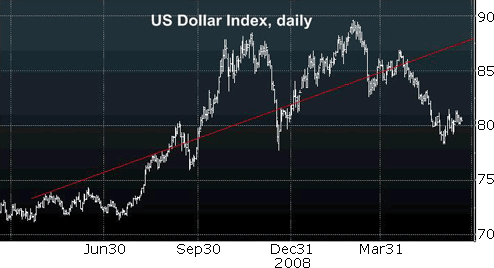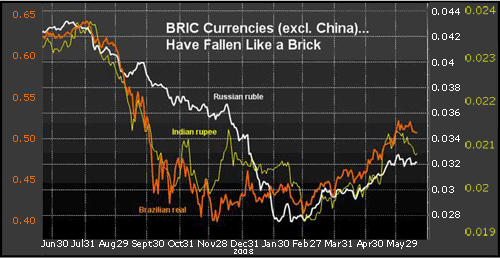Why “BRIC” Posturing Against the U.S. Dollar Just Doesn’t Add Up
Currencies / US Dollar Jun 21, 2009 - 01:29 AM GMT Bryan Rich writes: The dollar has been publicly attacked on many fronts over the past three months. And endless accusations have been made that the U.S. is purposely trying to devalue the dollar to lessen its growing debt burden.
Bryan Rich writes: The dollar has been publicly attacked on many fronts over the past three months. And endless accusations have been made that the U.S. is purposely trying to devalue the dollar to lessen its growing debt burden.
Sure, everyone understands the potential inflationary implications of the ultra-stimulative policy actions taken by the Fed. But inflation is unlikely to become an issue for quite some time. And when it does appear, then a judgment can be made as to how the Fed is managing it. Plus, other major countries have taken similar paths and will be facing the same challenges.
Nonetheless, huge stakeholders in the dollar like Brazil, Russia, India and China (the BRIC countries), the fastest growing emerging market economies of the past decade, have used the opportunity to stir the global power pot — making threats to move out of the dollar.
 |
| In total, the BRIC countries own nearly 32 percent of the U.S. Treasury market. |
These countries hold a combined total of nearly 42 percent of the world’s currencies. China has $2 trillion worth of currency reserves. Russia has $400 billion … India $260 billion and Brazil $206 billion. And combined they own nearly 32 percent of the U.S. Treasury market. So their threats tend to make some waves.
First it was China that called for a new world reserve currency just prior to the April G-20 meeting. Since then, those comments have been reinforced and repealed many times. And the issue was ignored at the G-20 meeting.
Now Russia is piling on, calling for a new “supranational” currency and recommending that the BRIC countries begin trading in local currencies, abandoning dollar-based trading.
Russian President Medvedev said, “We have to consolidate the international monetary system, not only through the consolidation of the dollar but the creation of new reserve currencies.”
But these comments out of the Russian administration have been balanced with just as many contradicting, dollar-supportive statements.
So is this simply political posturing or do these countries have the clout to make such assertions — and make things happen?
In reality, politicians do not determine a world reserve currency, markets do. And if the dollar continues to be the globally accepted currency of trade and store of value, then the majority of global governments and investors will continue to denominate capital in dollars.
Can Emerging Market Economies Make a Credible Movement Against the Dollar?
It’s no secret that the BRIC countries want more global political influence. In fact, they explicitly asked for it this week.
This is their attempt to strike while the iron is hot, to win market share of global influence. And the dollar is the media whipping boy … a perfect political tool. But then again, these countries have a large stake in the dollar, so the punches they throw have to be calculated and followed with counters and ambiguity.
It’s also important to remember that we’re talking about a group of countries that could sink back into economic anonymity just as quickly as they emerged.
Take a look at Russia for example …
When the housing market began to fall in the U.S. and the financial system began to crack, the mantra of decoupling was making the rounds. Experts thought that emerging super-growth economies could operate independently of the U.S. and the world economy would keep on plugging away.
That was quickly and clearly proven wrong. And there was no country hit harder than Russia …
 |
| When the global demand for oil and natural gas collapsed, so did prices and the Russian stock market. |
First there was the collapse in global demand for oil and other commodities, followed by the collapse in prices. This sent Russia’s economy, heavily dependent on oil and gas exports, into a tailspin. The country’s stock market tumbled. In fact, after climbing 6600 percent between 1998 and 2008, Russian stocks fell 80 percent in just eight months last year — one of the steepest and deepest stock market declines in the world!
And as money was fleeing the Russian stock market, it was fleeing their currency, too. The ruble came under attack losing 58 percent of its value. The freefall stopped only after the Russian central bank stepped in to defend the ruble’s value by burning through more than 1/3 of its currency reserves buying rubles and selling more than $200 billion worth of dollars. The outlook for Russia was looking very bleak.
And it wasn’t just Russia that was exposed … it was the entire BRIC contingent! From peak to trough Chinese stocks lost 73 percent, Indian stocks lost 64 percent and Brazilian stocks lost 60 percent.
What a Difference Three Months Make …
With the total collapse of the global financial system seemingly averted, the global risk appetite has now improved. And the perception of recovery is breathing life back into commodities, global asset values and emerging market investments.
This week the BRIC countries gathered. And on the premise of diversifying their exposure to the dollar, they proposed buying each other’s local–currency denominated bonds.
So instead of buying U.S. Treasuries, they think a safer bet would be a healthy mix, including the likes of Russian debt?
Boy, that sounds like a bad idea to me!
After all, Russia is just 11 years removed from defaulting on $40 billion in government debt.
Just Posturing?
In the face of the worst economic crisis since the Great Depression and unprecedented U.S. policy actions, the U.S. dollar is still up 14 percent, against a trade-weighted basket of major currencies, from its all-time lows last year. On top of that, as you can see in the chart below, the dollar remains in an uptrend …

Source: Bloomberg
Meanwhile, currencies in the BRIC region have been decimated, with the exception of China — which has manipulated its currency in a virtual flat-line against the dollar since the crisis commenced.
Today, even after some recovery, the Russian ruble remains down 35 percent, the Brazilian real is down 27 percent and the Indian rupee is down 23 percent versus the dollar.
But most importantly, from peak to trough these currencies lost 58 percent, 69 percent and 33 percent respectively against the dollar at the height of the crisis. Take a look at my second chart below, and you’ll realize how drastic this fall was.

Source: Bloomberg
This underscores the vulnerability of these less developed, less dynamic economies and emphasizes the fragile nature of their financial markets and currencies.
Despite all of the tough talk, the dollar is holding firm and central bank reserves continue to build dollar exposure at an increasing rate. So beware of the scare headlines — the dollar’s demise is greatly exaggerated.
Regards,
Bryan
This investment news is brought to you by Money and Markets . Money and Markets is a free daily investment newsletter from Martin D. Weiss and Weiss Research analysts offering the latest investing news and financial insights for the stock market, including tips and advice on investing in gold, energy and oil. Dr. Weiss is a leader in the fields of investing, interest rates, financial safety and economic forecasting. To view archives or subscribe, visit http://www.moneyandmarkets.com .
Money and Markets Archive |
© 2005-2022 http://www.MarketOracle.co.uk - The Market Oracle is a FREE Daily Financial Markets Analysis & Forecasting online publication.



